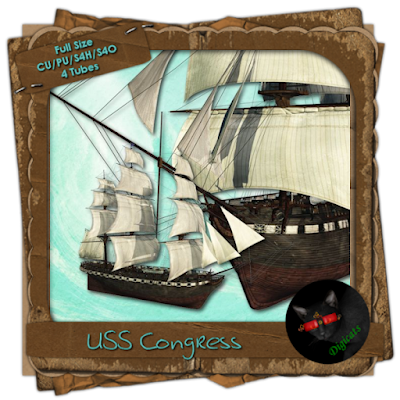CSS Patrick Henry was built in New York City in 1859 by the renowned William H. Webb for the Old Dominion Steam Ship Line as the civilian steamer Yorktown, a brigantine-rigged side-wheel steamer. She carried passengers and freight between Richmond, Virginia and New York City. Yorktown was anchored in the James River when Virginia seceded from the Union on 17 April 1861 and was seized by the Virginia Navy and later turned over to the Confederate Navy on 8 June 1861.
Commander John Randolph Tucker, who commanded the ship, directed that Yorktown be converted into a gunboat and renamed Patrick Henry in honor of that revolutionary patriot.
She also served as the first flagship of the James River Squadron.
This commercial use pack contains three full size tubes of this historic steamship for use in your kits and projects. Each tube is saved to 300 DPI, making it perfect for both web and print use.
CU/PU/S4H/S4O okay.
CSS Raleigh was originally a small, iron-hulled, propeller-driven towing steamer operating on the Albemarle and Chesapeake Canal. She was taken over by the State of North Carolina in May 1861, and transferred to the Confederate States the following July.
Her commanding officer during 1861–1862 was Lieutenant Joseph W. Alexander. Her entire service was in coastal waters of North Carolina and Virginia and in the James River as part of the James River Squadron.
Raleigh, renamed Roanoke near the end of the war, was destroyed by the Confederates on April 4, 1865 to prevent capture upon the evacuation of Richmond, Virginia.
This commercial use pack contains 3 full size tubes of this historic vessel for use in digital scrap kits and projects. Each tube is saved to 300 DPI. Make it perfect for both web and print use.
CU/PU/S4H/S4O okay.
Sail boats come in all shapes and sizes, but few can match this beautiful double masted sailing yacht. You'll want to sail away on this one!
This poser set contains 5 full size sailing yachts for use in your scrapbook kits and projects. Each tube is saved to 300 DPI making it perfect for both print and web use.
CU/PU/S4H/S4O okay!
USS Congress was a nominally rated 38-gun wooden-hulled, three-masted heavy frigate of the United States Navy. She was named by George Washington to reflect a principal of the United States Constitution. James Hackett built her in Portsmouth New Hampshire and she was launched on 15 August 1799. She was one of the original six frigates whose construction the Naval Act of 1794 had authorized. Joshua Humphreys designed these frigates to be the young Navy's capital ships, and so Congress and her sisters were larger and more heavily armed and built than the standard frigates of the period.
Her first duties with the newly formed United States Navy were to provide protection for American merchant shipping during the Quasi War with France and to defeat the Barbary pirates in the First Barbary War. During the War of 1812 she made several extended length cruises in company with her sister ship President and captured, or assisted in the capture of twenty British merchant ships. At the end of 1813, due to a lack of materials to repair her, she was placed in ordinary for the remainder of the war. In 1815 she returned to service for the Second Barbary War and made patrols through 1816. In the 1820s she helped suppress piracy in the West Indies, made several voyages to South America, and was the first U.S. warship to visit China. Congress spent her last ten years of service as a receiving ship until ordered broken up in 1834.
This commercial use pack contains four tubes of this beautiful historic vessal for use in your digital scrap kits and projects. Each tube is saved to 300 DPI, making it perfect for both print and web use.
CU/PU/S4H/S4O okay.
Available for just $1 per pack at:








1 comment:
I’m glad to locate so much of informative data in your blog.
Likeable Pets
Post a Comment